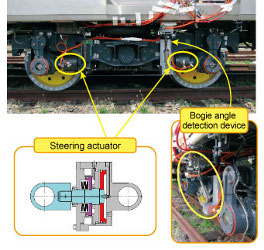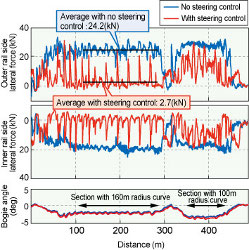10. Mechanical pneumatic steering system with failsafe function
Proposals have been made for steering systems which improve driving performance through curves by extending the wheel base on the outer rail, however, given the risk of reverse steering due to an operational malfunction in an electrically powered steering system, the proposal was not adopted for practical development. Following this, a safer steering system was developed which performs mechanical steering control based on the angle between the vehicle and the bogie when driving through a curve (Figure 1).
The proposed system does not require electrically powered control for steering due to the new link mechanism which connects the device which detects the bogie angle based on interaction between the vehicle and the bogie while running, with the compressed air control valve for supplying compressed air to the steering actuator.
The steering actuator also has a built-in anti-reverse steering valve, creating a mechanism where active steering with compressed air is only possible in the direction of the self-steering force of the wheel. At the same time, if a malfunction arose with the air distribution system, the normal longitudinal stiffness of the primary suspension acts as a fail-safe mechanism.
Tests on a vehicle equipped with the proposed system showed that the new steering device reduced lateral forces by 80% compared to no steering control (Figure 2). Furthermore, in the case of a hypothetical malfunction causing reverse steering, confirmation was obtained that the anti-reverse steering valve prevented an increase in lateral force.
As the present system was built for a bolsterless bogie, it can be made light and compact with the same level of performance for heavier, more complex, bolstered bogie-angle linked steering trucks.
Future tasks for the development of this device include high-speed performance tests which could not be conducted on the running test track at RTRI, and durability tests on the bogie angle detection device, which are required before placing the system into service.
Other Contents
- 1. Seismic ground motion simulator applicable to M9 earthquakes
- 2. Seismic Hazard simulator for railways
- 3. Early warning system employing ocean bottom seismometer data
- 4. Development of Railway Embankment Structures Resistant to severe Earthquakes and Prolonged Overflows caused by Tsunamis
- 5. Measures against buckling of ballasted track during earthquakes
- 6. Disaster Hazard Mapping Technology
- 7. Method for diagnosing condition of concrete roadbed in tunnels
- 8. Analytical method for evaluating carbody safety aimed at reducing passenger injury in case of level crossing collisions
- 9. Bogie to control decrement in wheel load
- 10. Mechanical pneumatic steering system with failsafe function
- 11. Gear oil for Shinkansen trains with improved startability in low temperature conditions
- 12. Process to select appropriate sounds to convey in-cab driver alerts
- 13. Training in communication techniques for train dispatchers in disrupted situations
- 1. Seismic ground motion simulator applicable to M9 earthquakes
- 2. Seismic Hazard simulator for railways
- 3. Early warning system employing ocean bottom seismometer data
- 4. Development of Railway Embankment Structures Resistant to severe Earthquakes and Prolonged Overflows caused by Tsunamis
- 5. Measures against buckling of ballasted track during earthquakes
- 6. Disaster Hazard Mapping Technology
- 7. Method for diagnosing condition of concrete roadbed in tunnels
- 8. Analytical method for evaluating carbody safety aimed at reducing passenger injury in case of level crossing collisions
- 9. Bogie to control decrement in wheel load
- 10. Mechanical pneumatic steering system with failsafe function
- 11. Gear oil for Shinkansen trains with improved startability in low temperature conditions
- 12. Process to select appropriate sounds to convey in-cab driver alerts
- 13. Training in communication techniques for train dispatchers in disrupted situations


